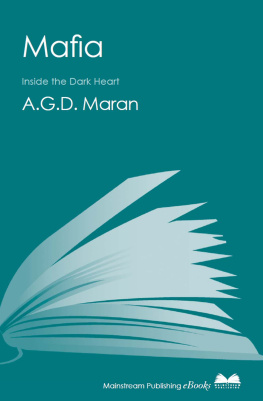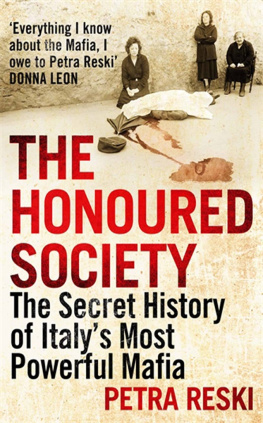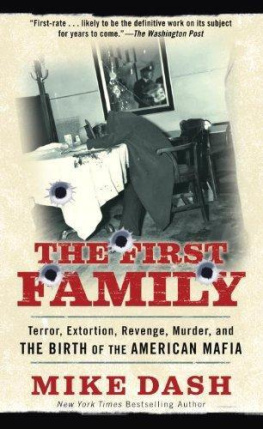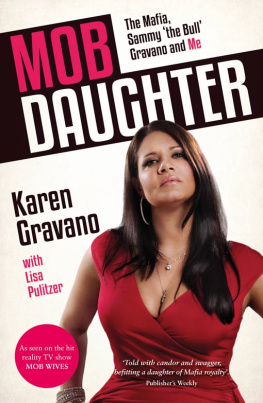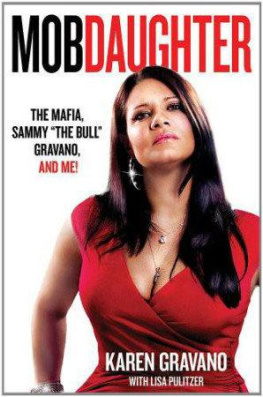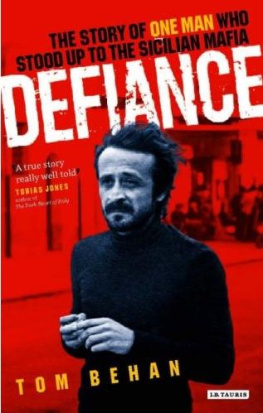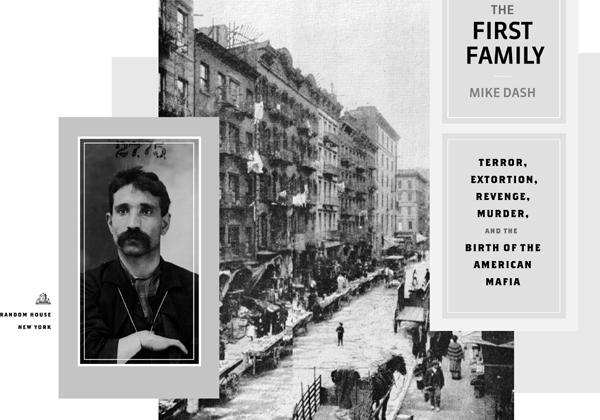Between the law and the Mafia, the law is not the most to be feared.
PREFACE
H UNDREDS OF BOOKS HAVE BEEN WRITTEN ABOUT THE MAFIA , but this one is different from the rest. Its focus is the birth of the American branch of the fraternity during the years between 1892 and 1930a period that has, to my astonishment, been almost entirely neglected until now. Few writers have ever asked how, exactly, the Mafia came into existence in the United States. The First Family does.
The vast majority of Mafia books are also notoriously unreliable: compiled from rumor, hearsay, wild assumptions, and the endlessly recycled errors of earlier authors. The First Family sets out to correct these faults. The book is painstakingly rooted in primary sourcesnot least the detailed records of the U.S. Secret Service, the New York bureau of which was the only federal, state, or city agency to keep the earliest Mafiosi under systematic surveillance. This bureaus daily reports covering the key years from 1899 to 1916 fill fifty-nine huge volumes, each well over a thousand pages long, and among them they make up by far the greatest trove of reliable information on the Mafias formative years; they form the bedrock on which my narrative has been erected. To my bafflement, I found no sign that any other writer on the subject has ever bothered to examine them.
The balance of the story has been drawn from other important but neglected records: more than ten thousand pages of century-old trial transcripts, the detailed confession of a key member of an important Mafia counterfeiting ringwhich turned up in the Hoover Presidential Library, of all placesand the letters and personal memoirs of several participants, not least William Flynn, who was the chief of New Yorks Secret Service bureau, with a single brief hiatus, from 1901 until 1917. Flynns recollections, which were serialized in various contemporary newspapers, have likewise escaped attention until now, and they have been supplemented with the copious daily coverage of crime provided by well over a dozen early-twentieth-century papers. Taken together, this material makes it possible to reconstruct the events of a century ago in often-minute detail.
The story that emerges differs in many vital respects from the accounts that have been offered hitherto, most of which are heavily polluted with misinformation. When I first began my research four years ago, I read that Giuseppe Morello, the first great boss of the New York Mafia, was born in 1863 or 1870or, some said, perhaps in 1880. Contacting the registry office in his Sicilian hometown, Corleone, I discovered that the correct date was May 2, 1867a fact his own family seems to have been unaware of, since his gravestone bears the 1870 date. Another account held that Giuseppe had a brother, Antonio, who preceded him as boss in New York, and who once shot dead the dreaded leader of a rival criminal society, the Camorra. The battered transcripts of Antonio Morellos 1892 murder trial, rescued in the early 1980s from a dumpster and now archived in an obscure law library, reveal that he was neither a member of the Mafia nor any relation to his more celebrated brother, and also that the man he killed was a one-armed organ grinder with no criminal record who had crudely insulted Morellos wife.
Since the story that emerged from my own years of research is frankly astonishing, I also want to make it clear that nothing of what follows is fiction or imagined history. None of the conversations reported in these pages is invented; each was recalled, word for word, by one of the participants, or noted down by a newspaper reporter. As any historian should, I have listed my sources of information paragraph by paragraph, and line by line where necessary, and these can be verified in the end-notes.
The First Family, in short, is not a rehash of the cursory, inaccurate, invented tales you may have read before.
This is how it really happened.
M IKE D ASH
London, April 22, 2009
CONTENTS
CHAPTER 1
CHAPTER 2
CHAPTER 3
CHAPTER 4 The Most Secret and Terrible
Organization in the World
CHAPTER 5
CHAPTER 6
CHAPTER 7
CHAPTER 8
CHAPTER 9
CHAPTER 10
CHAPTER 11
CHAPTER 12
CHAPTER 13
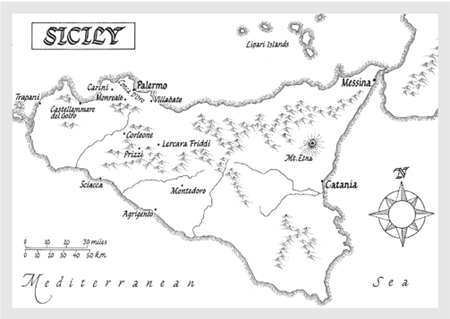
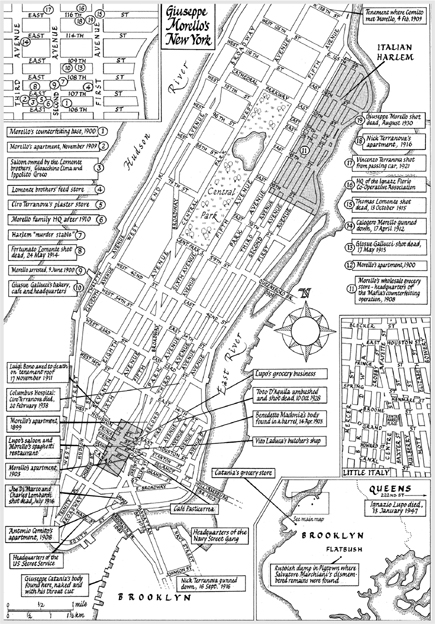
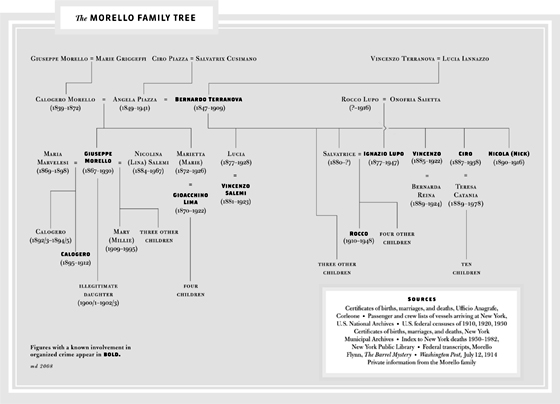
ROGUES GALLERY
T HE M ORELLO F AMILY
GIUSEPPE MORELLO aka The Clutch Hand, Little Finger, and One Finger Jack. Founder and leader of the first Mafia family in New York and boss of bosses of the American Mafia until 1910. Born in Corleone, Sicily, in 1867; suspected of murder and cattle rustling there and found guilty of counterfeiting. Arrived in the United States in 1892; arrested on charges of counterfeiting in 1900 and in connection with the Barrel Murder in 1903; lead suspect in the unsolved disappearance and probable murder of a teenage servant girl; New York Police Department (NYPD) rap sheet shows further arrests on suspicion of kidnapping and bomb throwing; organized extensive extortion ring and numerous rackets; suspected of involvement in up to sixty murders. Imprisoned 1910-20; on his release was sentenced to death by the Mafias general assembly. Overturned death sentence and became an influential adviser to the second generation of Mafia bosses. Murdered August 1930 by rival Mafiosi.
MARIA MARVELESI Morellos first wife; born Corleone, Sicily; immigrated to the United States 1893; mother of two sons, both named Calogero. Died 1898.
LINA MORELLO Ne Nicolina Salemi. Morellos second wife; born Corleone, immigrated to the United States 1903 and married Morello the same year; four children. Complicit in various criminal schemes; hid Mafia correspondence and extortion letters in her childs diapers. Outlived her husband by thirty-seven years.
IGNAZIO LUPO Palermo Mafioso better known as Lupo the Wolf. Immigrated to the United States around 1898; married Morellos sister. Found guilty of murder in Sicily; suspect in the murder of Giuseppe Catania in Brooklyn, 1902; suspect in the Barrel Murder case, 1903; NYPD rap sheet shows further arrests for arson, sending threatening letters, kidnapping, and issuing death threats. Set up Mafia money-laundering schemes. Ran chain of grocery stores; bankrupted 1908; convicted of counterfeiting 1910 and sentenced to thirty years. Paroled 1920. Sentenced to death with Morello by the Mafias general assembly and fled to Sicily; returned 1922 and ran fruit and bakery rackets; suspect in a 1930 murder; charged with another killing, 1931; rearrested 1936 and returned to jail to serve out the remainder of his 1910 counterfeiting sentence. Released 1947 and died three weeks later.


